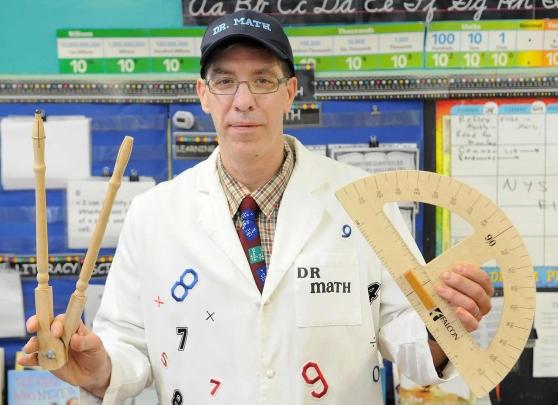
"Dr. Math" (also known as 5th-grade teacher Walter Stark) visits the classroom at PS 108 in Queens to engage and entertain students.
When the 5th-grade students at PS 108 in Ozone Park, Queens, need a boost of positive energy, they get a special visit from “Dr. Math.” Wearing a lab coat emblazoned with colorful numerals, Dr. Math presents students with a precious gemstone and a coveted no-homework pass.
“I’ve become very good at going into my classroom and showing students how much fun school can be,” says Dr. Math’s alter ego, teacher Walter Stark. “Learning should be exciting and fun, because there’s nothing better than discovering something with your friends.”
During the pandemic, it has become harder to center fun at the forefront of learning (even the buoyant Dr. Math admits he’s “mentally and physically burned out”).
“One of the biggest things we noticed, especially last year, was a lack of joy,” says Jared Van Zweeden, a middle school ELA teacher at Ballet Tech in Manhattan. “Kids were muted, with their cameras off, with no opportunity to have side conversations or tell jokes — all the other learning kids do aside from academics. There was a lack of engagement and camaraderie, which is a big part of what they come to school for.”
Now, with spring in bloom, teachers are exploring creative ways to bring joy into their classrooms during a stressful time. Here are some ideas that have worked for them.
Van Zweeden and his colleagues decided to plan bimonthly festive events for students. On the Thursday before the winter break, for example, students spent an entire day participating in a series of winter-themed activities, such as a desk-decorating competition and a crystal-growing activity.
“They got to hang out, socialize, be creative with materials and have fun,” Van Zweeden says.
Luis Sanchez, a special education teacher in a kindergarten ICT classroom at PS 300 in the Bronx, has looked for opportunities in his regular curriculum to create unique experiences for students who “have never had a normal school year.”
“We have a unit on falling in love with authors where we read books by Asian-American author Grace Lin, who writes about her culture and food like fortune cookies and dim sum,” he says.
Sanchez and his co-teacher brought in different dim sum foods, acted like waiters and offered the kids choices. “They loved it,” he says. “Those are the things that kids remember most. Those fun moments are what make school school.”
Thursdays have a theme in Melanie Pflaum’s math class at Bard HS Early College on the Lower East Side: In lieu of a typical lesson, students work on an investigative task, puzzle or project.
Known as “Fun Thursdays,” the activities sometimes involve candy — a recent task featured M&Ms as models for exponential decay — and music. But more important, they give students a low-stakes chance to try different approaches to problem-solving.
“As a high school teacher, you can feel pressure that every day you’re not teaching a topic, you’re not doing your job,” says Pflaum. “But if you don’t take the time to allow kids to fail, they’ll never be engaged.”
This year Stark, the 5th-grade teacher, has also emphasized the importance of allowing students to approach academics in a more unstructured way — for example, assigning open-ended journal assignments in writing rather than traditional essays.
“They’re stressed in general, and hitting them with assessments takes away from the joy of learning something,” he says.
He teaches students that mistakes are opportunities for celebration, not despair.
“We love mistakes,” he says firmly. “You got something totally wrong? That’s fantastic. Now we know what not to do.”
A favorite mistake is a classic math problem in which students need to figure out how many chickens and how many pigs live on a farm, based on the number of legs.
“It’s difficult to figure out, so we work in groups and laugh about it,” Stark says. “That sense of community helps my room flow.”
Grand gestures aren’t necessary to transform ordinary classroom moments into joyous ones.
“My philosophy is to try to take the dullest moments and make them fun and silly,” says Sanchez, the kindergarten teacher.
At PS 108, a schoolwide initiative encourages everyone to “drop everything and read” for 10 minutes when the principal plays music on the loudspeaker — the anticipation and surprise add levity to the daily routine.
Sanchez’s students also practice different types of cheers and applause to motivate one another. A favorite is “rocket applause,” where everyone’s hands shoot upward while they clap.
“It’s really created a strong, loving bond in our classroom,” Sanchez says. “You get to learn more about kids when you incorporate fun, authentic activities that let them express who they are.”